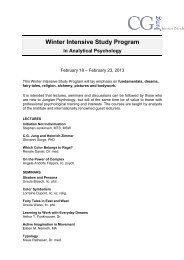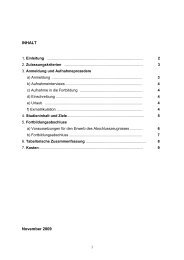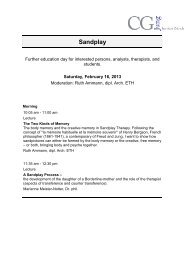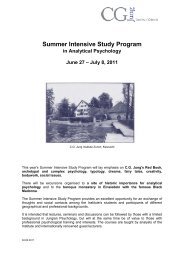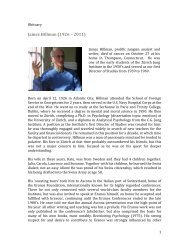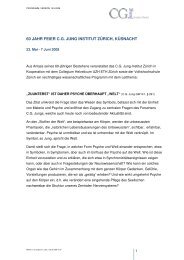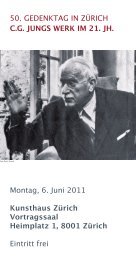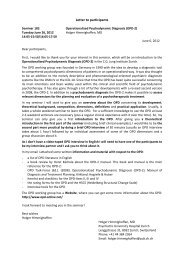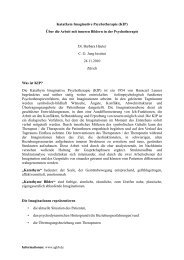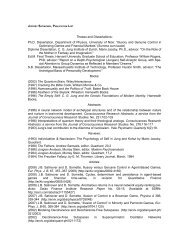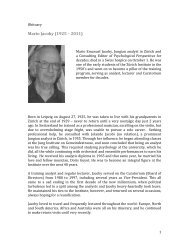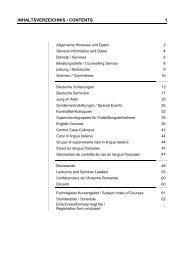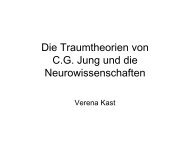The Red Book - CG Jung Institut Zürich
The Red Book - CG Jung Institut Zürich
The Red Book - CG Jung Institut Zürich
Sie wollen auch ein ePaper? Erhöhen Sie die Reichweite Ihrer Titel.
YUMPU macht aus Druck-PDFs automatisch weboptimierte ePaper, die Google liebt.
C.G.<strong>Jung</strong><br />
Das Rote Buch<br />
Zweifel und Sinnsuche quälten den Schweizer Tiefenpsychologen<br />
Carl Gustav <strong>Jung</strong> (1875–1961) in seiner Lebensmitte. In der schwierigen<br />
Zeit nach der Trennung von Sigmund Freud begann <strong>Jung</strong> mit<br />
der Arbeit am Roten Buch, in dem er seine Träume und Visionen<br />
aufzeichnete. Aus der intensiven Selbsterforschung entwickelte<br />
<strong>Jung</strong> später seine bekannten <strong>The</strong>orien. Während seiner Arbeit am<br />
Roten Buch unternahm er mehrere Reisen, die ihn unter anderem<br />
zu den Pueblo-Indianern Neu-Mexikos, in die Oasenstädte Nordafrikas<br />
und in die Buschsavanne Ostafrikas führten.<br />
Grossformatig gestaltet ist das zwischen 1914 und 1930 entstandene<br />
“Rote Buch” durchaus als Gesamtkunstwerk zu bezeichnen.<br />
Das annähernd sieben Kilogramm schwere, in rotes Leder gebundeneWerk<br />
ist in eigenartig feierlicher deutscher Sprache verfasst,<br />
in kunstvoller Kalligrafie mittelalterlicher Handschriften gehalten<br />
und mit farbenprächtigen Illustrationen versehen.<br />
Nach <strong>Jung</strong>s Tod ruhte das Rote Buch über 50 Jahre in einem Banktresor.<br />
2009 ist dieses erstaunliche und rätselhafte Werk in New<br />
York der Öffentlichkeit zugänglich gemacht worden. Nun wird es<br />
erstmals in Europa gezeigt.<br />
Da <strong>Jung</strong>s Reisen und somit das Buch auch von der Auseinandersetzung<br />
mit fremden Kulturen, Symbolen und Religionen zeugen,<br />
war das Museum Rietberg als Ausstellungsort naheliegend. In<br />
<strong>Zürich</strong> werden Gemälde und Skulpturen C.G. <strong>Jung</strong>s aus Familienund<br />
Privatbesitz gezeigt, die zeitgleich mit der Arbeit am Roten<br />
Buch entstanden sind; darunter auch bildhauerische Werke, die<br />
noch nie öffentlich zu sehen waren.<br />
Die Ausstellung wurde organisiert in Zusammenarbeit mit der Stiftung<br />
der Werke von C.G. <strong>Jung</strong>, <strong>Zürich</strong>. Gastkurator: Prof. Sonu Shamdasani<br />
Zur Ausstellung erscheint ein kleinformatiger illustrierter Ausstellungs -<br />
führer (d/f/e). CHF 4<br />
Ein reichhaltiges Rahmenprogramm begleitet die Ausstellung.<br />
www.rietberg.ch<br />
Carl Gustav <strong>Jung</strong> (1875–1961)<br />
Das Rote Buch<br />
Stiftung der Werke von C.G. <strong>Jung</strong>, <strong>Zürich</strong><br />
Carl Gustav <strong>Jung</strong> (1875 –1961)<br />
Das Rote Buch<br />
Stiftung der Werke von C.G. <strong>Jung</strong>, <strong>Zürich</strong><br />
<strong>The</strong> <strong>Red</strong> <strong>Book</strong><br />
In the middle of his life, the Swiss analytical psychologist Carl<br />
Gustav <strong>Jung</strong> (1875 –1961) went through a period of personal and<br />
spiritual turmoil. Following his painful break with Sigmund Freud,<br />
<strong>Jung</strong> started to work on <strong>The</strong> <strong>Red</strong> <strong>Book</strong>, in which he recorded<br />
his dreams and visions, and this intensive self-exploration led<br />
him to develop his most important theories. While assembling<br />
<strong>The</strong> <strong>Red</strong> <strong>Book</strong> he went on a number of journeys, which included<br />
visits to the home of the Pueblo Indians in New Mexico, the<br />
oasis towns of North Africa, and the East African savanna.<br />
Created between 1914 and 1930, the ornate, large-format <strong>Red</strong><br />
<strong>Book</strong> can truly be called a Gesamtkunstwerk, a total artwork.<br />
Weighing almost seven kilos, bound in red leather, it is composed<br />
in strangely solemn German, written in the intricate calligraphy<br />
of medieval manuscripts, and lavishly illustrated.<br />
After <strong>Jung</strong>’s death, <strong>The</strong> <strong>Red</strong> <strong>Book</strong> languished in a bank vault for<br />
more than fifty years. In 2009, this remarkable and mysterious<br />
work was finally displayed to the public in New York. Now it is<br />
being shown for the first time in Europe.<br />
Since <strong>Jung</strong>’s journeys and therefore the book as well are a testimony<br />
to his exploration of foreign cultures, symbols, and religions,<br />
the Museum Rietberg seems like an obvious place for<br />
this exhibition. In Zurich, paintings and sculptures by C.G. <strong>Jung</strong><br />
from family and private collections will be shown which were<br />
created during the same period as his work on <strong>The</strong> <strong>Red</strong> <strong>Book</strong>;<br />
among them sculptures which have never before been displayed<br />
in public.<br />
<strong>The</strong> exhibition was organised in collaboration with the Foundation of<br />
the Work of C.G. <strong>Jung</strong>, Zurich.<br />
Guest curator: Professor Sonu Shamdasani<br />
A small-format illustrated guide will be published to accompany the<br />
exhibition (d/f/e). CHF 4<br />
A full programme of events accompanies the exhibition.<br />
For further information, see www.rietberg.ch<br />
Le Livre rouge<br />
Vers la quarantaine, le psychanalyste suisse Carl Gustav <strong>Jung</strong><br />
(1875–1961) traverse une période d’incertitude intérieure. Tourmenté<br />
et en quête de sens dans cette période difficile qui suit<br />
la rupture avec Sigmund Freud, <strong>Jung</strong> commence à travailler à<br />
son Livre rouge, dans lequel il note ses rêves et ses visions.<br />
C’est à partir de cette analyse approfondie de sa personnalité<br />
que <strong>Jung</strong> développera plus tard ses célèbres théories. Alors<br />
qu’il travaillait au Livre rouge, il entreprit plusieurs voyages qui<br />
le conduisirent notamment chez les indiens Pueblos du Nouveau-Mexique,<br />
dans les villes des oasis d’Afrique du Nord et<br />
dans la savane d’Afrique de l’Est.<br />
Le Livre rouge – un ouvrage de grand format réalisé entre 1914<br />
et 1930 – peut être, à juste titre, considéré comme une «œuvre<br />
d’art totale». Ce volume relié de cuir rouge et pesant presque<br />
sept kilos est rédigé dans un allemand curieusement solennel;<br />
le texte est calligraphié en lettres gothiques rappelant les<br />
manuscrits médiévaux et orné d’illustrations aux couleurs<br />
somptueuses.<br />
Après la mort de C.G. <strong>Jung</strong>, le Livre rouge est resté plus de<br />
cinquante ans enfermé dans un coffre de banque. En 2009, cet<br />
ouvrage aussi étonnant que mystérieux a été présenté au<br />
public à New York. Aujourd’hui, il est exposé pour la première<br />
fois en Europe.<br />
Du fait que les voyages de <strong>Jung</strong> – et, par conséquent, ce livre<br />
– témoignent de son intérêt pour certaines civilisations et religions<br />
étrangères ainsi que leurs symboles, le choix du Musée<br />
Rietberg comme lieu d’exposition s’imposait. A Zurich, le public<br />
pourra admirer des peintures et des sculptures de C.G. <strong>Jung</strong><br />
qui sont encore en possession de la famille ou proviennent de<br />
collections privées et qui ont été réalisées à l’époque où il travaillait<br />
au Livre rouge. Parmi elles se trouvent également des<br />
sculptures qui n’avaient encore jamais été exposées.<br />
L’exposition a été organisée en collaboration avec la Fondation des<br />
œuvres de C.G. <strong>Jung</strong>, Zurich.<br />
Commissaire invité: Professeur Sonu Shamdasani<br />
Un petit guide d’exposition illustré (d/f/e) paraîtra à l’occasion de<br />
l’exposition. CHF 4<br />
Parallèlement à l’exposition, un programme d’accompagnement particulièrement<br />
riche sera proposé. Informations détaillées et manifes -<br />
tations sous www.rietberg.ch
Führungen<br />
Jeden Samstag, 14h<br />
Öffentliche Führung durch die Ausstellung<br />
mit Mitarbeitenden des C.G. <strong>Jung</strong> <strong>Institut</strong>s<br />
und des Internationalen Seminars für Analytische<br />
Psychologie <strong>Zürich</strong><br />
Privatführungen | Visites privées | Guided tours<br />
T. + 41 (0)44 206 3111/31<br />
Veranstaltungen<br />
Sonntag, 19. Dezember 2010, 11h<br />
Liber Novus :<br />
C.G. <strong>Jung</strong> and the ‘Art’ of Psychology<br />
Lecture by Prof. Sonu Shamdasani<br />
Sonntag, 16. Januar 2011, 11h<br />
Wandlungen des Gottesbildes in <strong>Jung</strong>s<br />
Rotem Buch : Von einer Spurensuche im<br />
“Schatzhaus der Menschheit”<br />
Vortrag von Prof. Dr. Ingrid Riedel<br />
Donnerstag, 20. und 27. Januar,<br />
3., 10. und 17. März 2011,<br />
jeweils 18.30h<br />
Künstlerische Interventionen und<br />
Gespräche<br />
Donnerstag, 3. und 17. Februar 2011,<br />
jeweils 19h<br />
“Das Rote Buch im Gespräch”<br />
<strong>Jung</strong>sche AnalytikerInnen diskutieren mit<br />
Vertretern der Öffentlichkeit<br />
Sonntag, 13. Februar 2011, 11h<br />
Das Fremde ist auch ein Teil von uns<br />
C.G. <strong>Jung</strong>s Begegnung mit fremden Kulturen<br />
Vortrag von Linda Briendl<br />
Detailinfos zu allen Veranstaltungen werden in separaten<br />
Flyern und auf www.rietberg.ch publiziert.<br />
Carl Gustav <strong>Jung</strong> (1875 –1961)<br />
Das Rote Buch, «Philemon»<br />
Stiftung der Werke von C.G. <strong>Jung</strong>, <strong>Zürich</strong><br />
Carl Gustav <strong>Jung</strong> (1875–1961)<br />
Das Rote Buch<br />
Stiftung der Werke von C.G. <strong>Jung</strong>, <strong>Zürich</strong><br />
Titelseite<br />
C.G. <strong>Jung</strong>, 1949, Foto: Dmitri Kessel<br />
Copyright: <strong>The</strong> Picture Collection Inc.<br />
Museum Rietberg <strong>Zürich</strong><br />
Gablerstrasse 15 | CH-8002 <strong>Zürich</strong><br />
T. + 41 (0)44 206 31 31 | F. + 41 (0)44 206 31 32<br />
Infoline + 41 (0)44 206 31 00<br />
museum.rietberg@zuerich.ch<br />
www.rietberg.ch<br />
Öffnungszeiten | Heures d’ouverture | Opening hours<br />
Di–So 10 –17h | Mi und Do 10 –20h<br />
ma–di 10 –17h | me/je 10 –20h<br />
Tue–Sun 10.00–17.00 | Wed and Thu 10.00– 20.00<br />
Festtage | Jours fériés | Holidays<br />
geschlossen 24. und 31.12. | geöffnet 25.12. und 1.1. 10 –17h<br />
fermé le 24 et 31 déc. | ouvert le 25 déc. et le 1er jan. 10 –17h<br />
closed on 24/12 and 31/12 | open on 25/12 and 1/1 10.00–17.00<br />
Eintritt | Entrée | Admission<br />
Erwachsene | adultes | adults CHF 16<br />
Ermässigt | réduit | reduced CHF 12<br />
Jugendliche bis 16 Jahre gratis | Entrée libre jusqu’à 16 ans<br />
Free admission for children under 16<br />
Führungen | Visites guidées | Guided tours<br />
Öffentliche Führungen Sa 14h<br />
Privatführungen | Visites privées | Guided tours<br />
T. + 41 (0)44 206 31 11/ 31<br />
Anreise | Accès | Directions<br />
Tram 7 Richtung Wollishofen bis «Museum Rietberg»<br />
(4 Haltestellen vom Paradeplatz). Keine Parkplätze;<br />
Behinderten-Parkplatz vorhanden.<br />
Tram nº 7 (en direction de Wollishofen) jusqu’à l’arrêt<br />
«Museum Rietberg» (4e station après Paradeplatz ).<br />
Pas de places de stationnement, sauf pour les handicapés.<br />
Tram 7 (direction Wollishofen) to «Museum Rietberg»<br />
(4 stops from «Paradeplatz»). No parking; disabled parking<br />
available.<br />
C.G.<strong>Jung</strong><br />
DasRoteBuch<br />
Museum Rietberg <strong>Zürich</strong><br />
18.12.2010–20.3.2011<br />
Fliegender Falke 30. Dynastie, Regierungszeit von Nektanebos II., 360–342 v.Chr., Mehrfarbige Fayence. <strong>The</strong> Metropolitan Museum of Art, New York, Ankauf, Schenkung Edward S. Harkness,1926 (26.7.991) © Metropolitan Museum of Art, New York<br />
Graphic Design: Elizabeth Hefti, Lithografie: Albert Walker, Druck: JCM Offsetdruck AG



